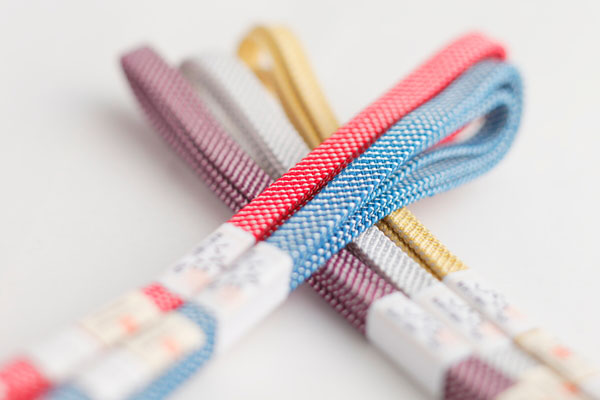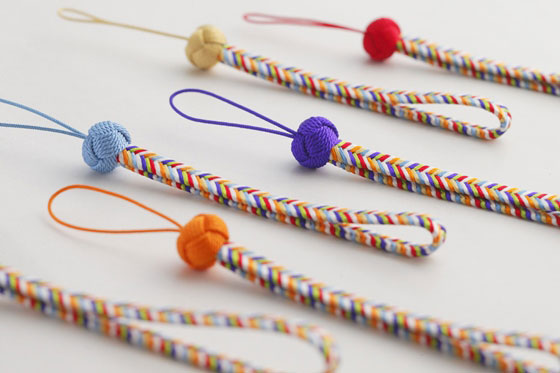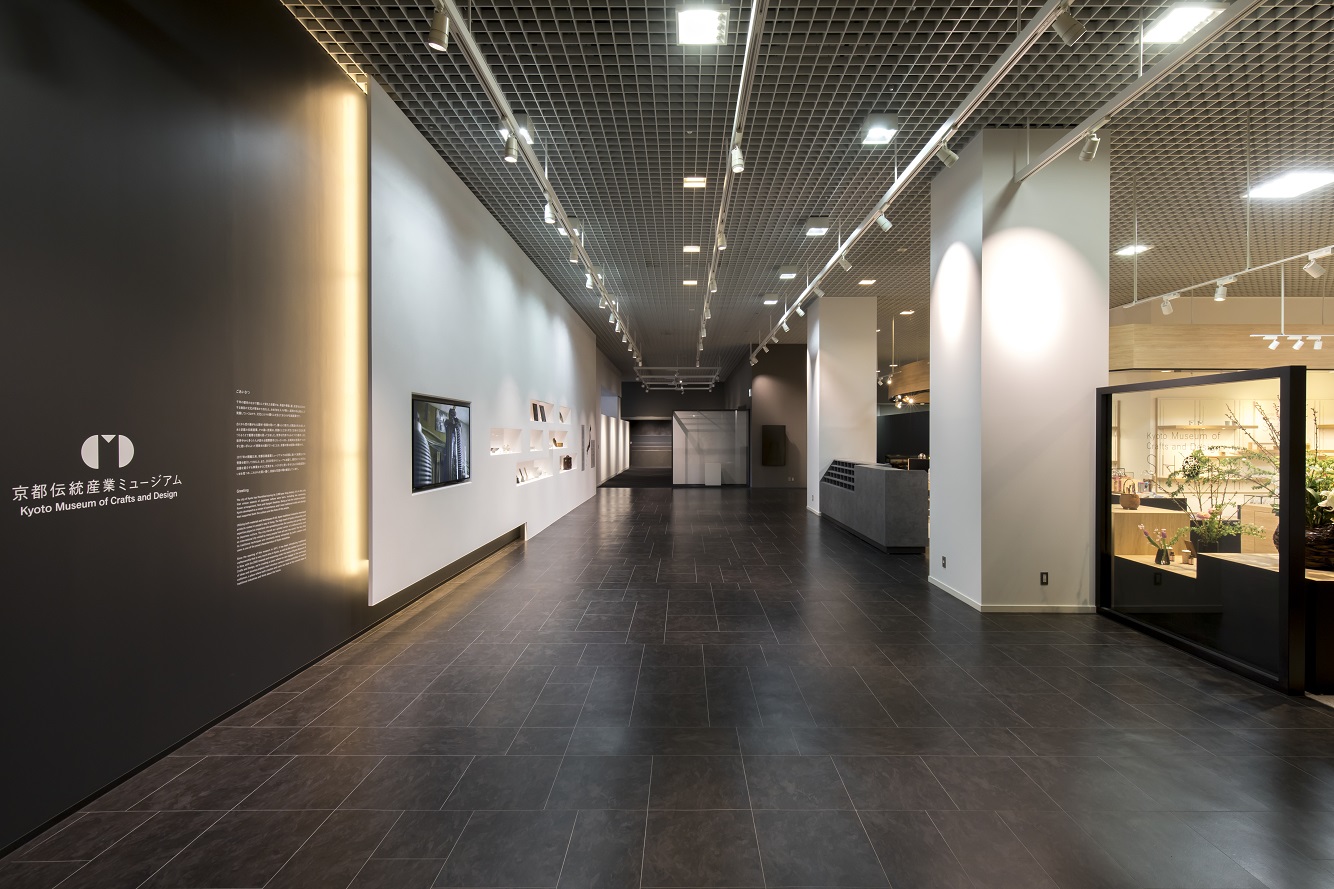
- Other textiles
- Kyoto
Kyo braided cords Kyo kumihimo
A graceful culture of knotted braids born in Kyoto
Handcraft combining refinement and practicality
Description
What is Kyo braided cords ?
Kyo Braided Cords (called Kyo Kumihimo in Japanese) are produced around the cities of Kyoto and Uji, Kyoto prefecture. Since the Heian period (794-1192), this craft has been found on prestigious and sacred pieces such as Buddhist and Shinto altar fittings. Because the cords were also used as decorative accessories by aristocrats and members of the Imperial family, Kyo Kumihimo production developed close to the seat of power and court in Kyoto, which was the capital at that time. A stunning range of beautiful cord patterns are hand-braided from silk threads. About three hundred or so different braiding techniques are said to be used with the designs varying from flat, round, square, or herringbone patterns. Such a broad range of cords gave natural rise to a diverse collection of specific tools and looms. Even today, Kyo Braided Cords have intricate braid patterns, knots, and the soft elegant sheen of silk threads. Not only do the cords look beautiful, they are also extremely durable, do not fray easily, and stay firmly knotted when tied such as when used for fixing obi (kimono sashes). The cords have been adapted for modern life as mobile phone straps and key rings.
History

Kumihimo dates back to the ancient Jomon period (14,000-300 BC) in the form of simple braided cords. Then during the Asuka (592-710) and Nara (710-794) periods, advanced braiding techniques were introduced from China and cord braiding developed as a skilled craftwork. In fact, the advanced technique of this craft during that time can be seen among the many artifacts stored in the Shosoin Repository*. With the rise of a distinctive Heian (794-1192) culture, designs evolved from those with a strong Chinese influence to those with Japanese-style tastes. As a reflection of the growing elegant culture of the Heian nobility, the braided cords were produced to adorn crownlike head pieces and decorate kimono with rich colors and more intricate braid patterns. During the Muromachi period (1336-1573), the spirit of wabi sabi (simplicity and refinement) became prominent as influenced by the tea ceremony and designs transformed from splendid extravagance to austere simplicity. With the increasing power of the samurai, beautiful and practical Kyo Braided Cords were used to secure weapons, armor, and helmets. In the Edo period (1603-1868), this craft was no longer the exclusive product of people with high standing. Use spread among all people and ever since the Meiji period (1868-1912), Kyo Braided Cords have been essential for securing kimono sashes.
*The Shosoin Repository is a building located in Nara, a former capital of Japan, that has been around since the eighth-century. It not only has a collection of treasures dating back to the Silk Road, it also preserves over 10,000 hand-written documents all dating from the Nara period (710–784). Today the repository is under the control of the Imperial Household Agency.
General Production Process
- 1. Thread preparation
The silk threads are weighed and divided into the number of kumihimo being made. The threads used are silk, cotton, gold, and silver.
- 2. Dyeing
The threads are dyed based on the design. They are dyed many times so that they will be an even color. As this is a very delicate process requiring various shades of color, it is outsourced to specialists. The coloring and shading is ordered in detail based on the design.
- 3. Spooling
The dyed threads are machine-spun onto a single wooden frame called kowaku.
- 4. Measuring
The spooled threads are spun onto a measuring frame. The threads are measured to the right length of the design. Not just one thread, but a combination of several threads are joined together and spun. Based on the design, the combination is prepared with several colors to give more elegance to the cord.
- 5. Twisting
Threads with uniform length and color are twisted and spun onto reels using a hatcho twisting machine. Twisting the threads increases their strength and creates sheen. This is the final process of preparing the threads before braiding.
- 6. Braiding
The twisted threads are braided and different braiding stands such as round, square, or high stands are used depending on the pattern. There are many braiding techniques like flat, square, and round. Within the round braiding technique, there are braiding techniques using only four spools of thread called yotsugumi, eight spools of thread called yatsugumi and another called edogumi. A spool wound with several threads is called a tama, and some braiding methods use up to a hundred of them. This craft differs from right-angle woven cords as it uses diagonal braiding to give a three-dimensional effect. During the braiding work, the same tension must be maintained to prevent uneven patterns, which requires great concentration. However, much of the basic work is simple repetition that can be learned by beginners, and the making of Kyo cord braiding has become popular as a hands-on activity for tourists.
- 7. Finishing
To finish the cord, decorative tassels are teased out from ends of the cord by carefully loosening the threads one by one. The base of the tassels is firmly tied and the tassels are cut to the correct length. Then, the tassels are steamed to smooth and adjust the condition of the braid, followed by rolling to ensure the braids are uniform. Kyo braided cords are often used for kimono sash bands. However, by knotting the cords to a designed form, they can be used as decoration. From traditional designs such as butterflies and adornments representing one's status or a form of lucky charm, the cords have been used for armor and to adorn Shinto altar fittings. Also, each noble household had their own knotting patterns for binding boxes and only family members or servants would know the exact techniques and knotting sequences, so if a box and its cords were tampered with, it would be immediately apparent, making the cords a form of security.
Where to Buy & More Information
Kyoto Museum of Crafts and Design

-
Address
-
Tel.+81-75-762-2670
-
ClosedDecember 29 to January 3
-
Business Hours9am to 5pm
-
Website































































































































































































































































































